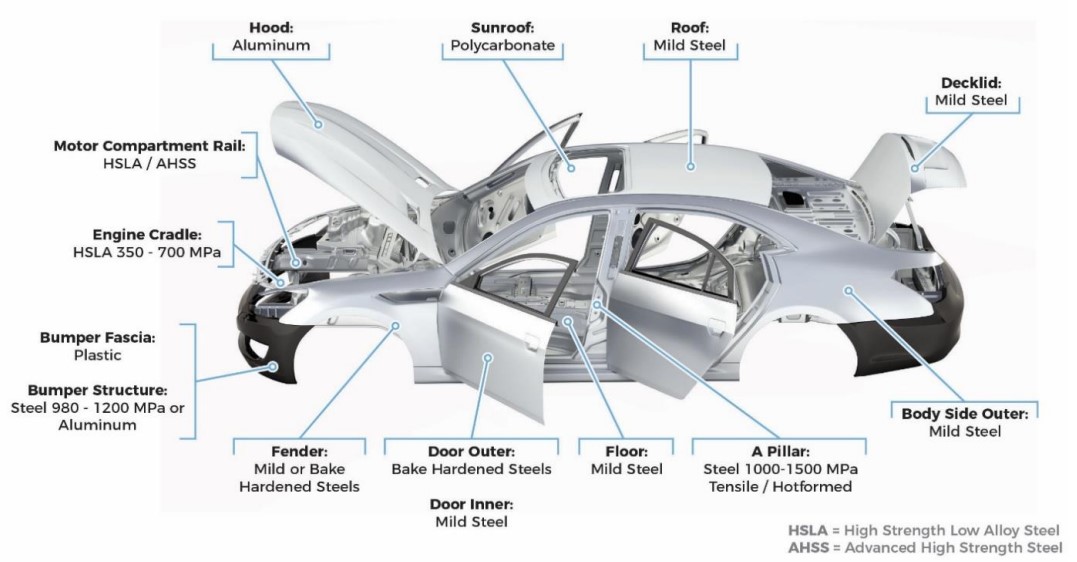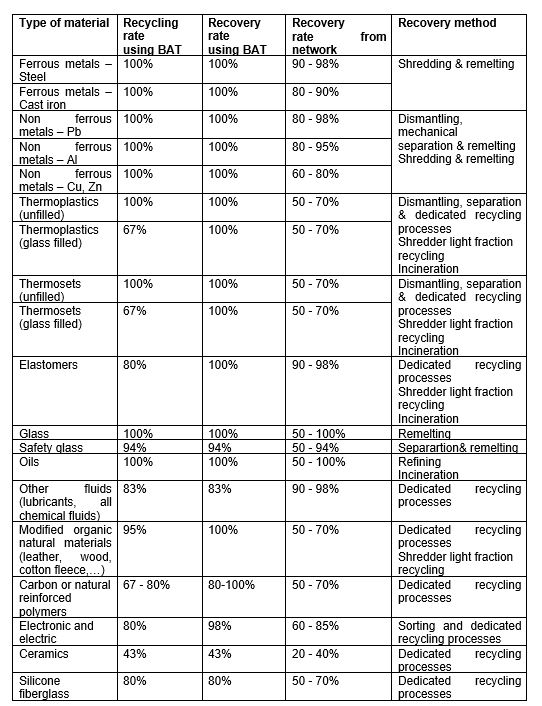Lesson 4: Automotive materials, recovery rates and methods of recovery
Lesson 4: Automotive materials, recovery rates and methods of recovery
In present, the most commonly used automotive materials include [[i]]:
Mild Steel: Mild steels are easy to form, which makes them a top choice for automotive parts manufacturers using cold stamping and other dated manufacturing processes. They have a maximum tensile strength of 270 MPa.
High Strength Steel (HSS): uses traditional steels and remove carbon during the baking cycle. This means softer steels can be formed and then baked into harder metals. Typical tensile strength grades range from 250 to 550 MPa.
High Strength Low Alloy (HSLA): HLSAs are carbon manganese steels strengthened with the addition of a micro alloying element such as titanium, vanadium, or niobium. These have a tensile strength up to 800 MPa and can still be press formed.
Advanced High Strength Steel (AHSS): Advanced high strength steels generally yield strength levels in excess of 550 MPa. They are composites made of multiple metals, then heated and cooled throughout the manufacturing process to meet a part’s specifications.
Ultra High Strength Steel (UHSS): These follow similar properties as AHSS but maintain strength levels of at least 780MPa.
Boron/Martensite: Martensite is the hardest and strongest form of steel, but it’s also the least formable. It shares properties with boron, which has a tensile strength of around 1,200 to 1,800 MPa. These are usually combined with softer steels to form composites.
Aluminum 5000/6000 (AL 5000/6000): 5000-series aluminum is alloyed with magnesium. 6000-series aluminum contains both silicon and magnesium which forms magnesium silicide and makes the aluminum alloy heat-treatable.
Magnesium: Magnesium is an attractive material for automotive use because of its light weight. When alloyed, magnesium has the highest strength-to-weight ratio of all structural metals.
Carbon Fiber Reinforced Plastic (CFRP): CFRPs are extremely strong, light plastics which contain carbon fibers to increase strength. They are expensive to produce but will have a growing demand in the future automotive industry as costs are reduced.

1‑5. Figure_ Materials Used Most Commonly for Major Vehicle Structure Components in the Current Fleet
[source: https://www.cargroup.org/wp-content/uploads/2017/07/Technology_Roadmaps.pdf]
Type of materials, their recovery rates and methods of recovery for ELVs are centralized in Table 1.1 [[i]].
Table 1.1_ ELV: Type of materials, their recovery rates and methods of recovery

[[i]] Smith, Brett, Adela Spulber, Shashank Modi, and Terni Fiorelli. (2017). Technology Roadmaps: Intelligent Mobility Technology, Materials and Manufacturing Processes, and Light Duty Vehicle Propulsion. Center for Automotive Research, Ann Arbor, MI https://www.cargroup.org/wp-content/uploads/2017/07/Technology_Roadmaps.pdf
[[i]] A Merkisz-Guranowska 2018 IOP Conference Series: Materials Science and Engineering, Volume 421, Issue 3, DOI 10.1088/1757-899X/421/3/032019